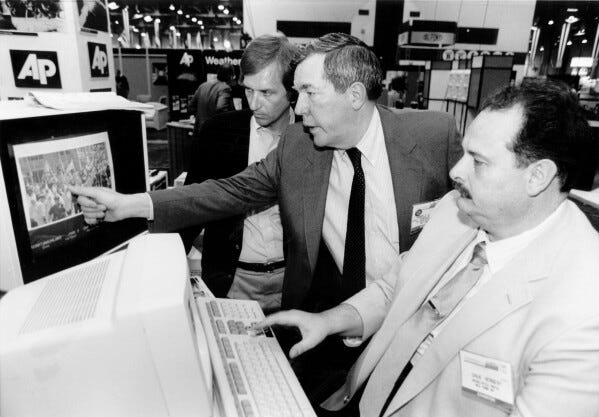A Mentor Leaves
News Photo Chief who moved AP to digital dies

How It Began
It’s not far from the truth when I tell people who ask about my early days at The AP that the primary requirement for being a staff photographer was the capability to make two different photos from an assignment. One for the morning papers. The other for the afternoon papers. An AMer and a PMer.
Both photos had to be good enough to make each paper think the other cycle got the better photo.
The only other requirement was that you must be able to make those two photos on the road carrying a portable darkroom in a suitcase-sized container, be able to find a spot in a home, store, or cheap hotel room to build a darkroom then connect a photo transmitter to a telephone line using alligator clips. Transmitting a single photo took 10 minutes.
How It Ended
You didn’t know Hal Buell. Yet his genius is in your hands every day.
When newspapers began transitioning to being able to run color photos, and ads, every day, Hal saw a future where AP photographers would be making photographs digitally and those photos being delivered to newspapers in minutes rather than hours.
The PhotoStream Electronic Picture Desk, pictured above, replaced copper telephone lines connecting individual newspapers to the AP network with satellite delivery of both black and white and color photos. Color photos that took 30 minutes to deliver over copper wires now took seconds.
Even as AP photographers continued to shoot film, the negatives were converted to digital with AP-designed and built scanners.
“In the ‘80s, when we went from black-and-white to all color, we were doing a good job to send two or three color pictures a day. Now we send 300,” Buell said in the 1997 AP newsletter.
Hal was instrumental in the design and delivery of the NC2000 digital camera to staffers and newspapers. The NC2000 was the first professional digital camera where its operation was transparent from film camera to digital camera. It used existing lenses and was built on the body of a Nikon or Canon film camera.
The rapid delivery of digital news photos transformed the newspaper business. Black and white photos were relegated to inside pages. Color photos were on every section front. Color became the norm.
The NC2000 demonstrated there was a market for professional digital cameras and that the technology for making and delivering digital photographs was not only possible, but it was also the future. Camera manufacturers saw an emerging market where newspaper photos demonstrated the capabilities of digital cameras.
There are other factors in the transition to digital but Hal’s early work to move The AP from slow analog delivery using leased copper wires to rapid satellite digital delivery changed the look of newspapers and introduced a digital world that is now taken for granted.
Hal Buell, who led The Associated Press’ photo operations from the darkroom era into the age of digital photography over a four-decade career with the news organization that included 12 Pulitzer Prizes and some of the defining images of the Vietnam War, has died. He was 92.

Buell died Monday in Sunnyvale, California, after battling pneumonia, his daughter Barbara Buell said in an email.
